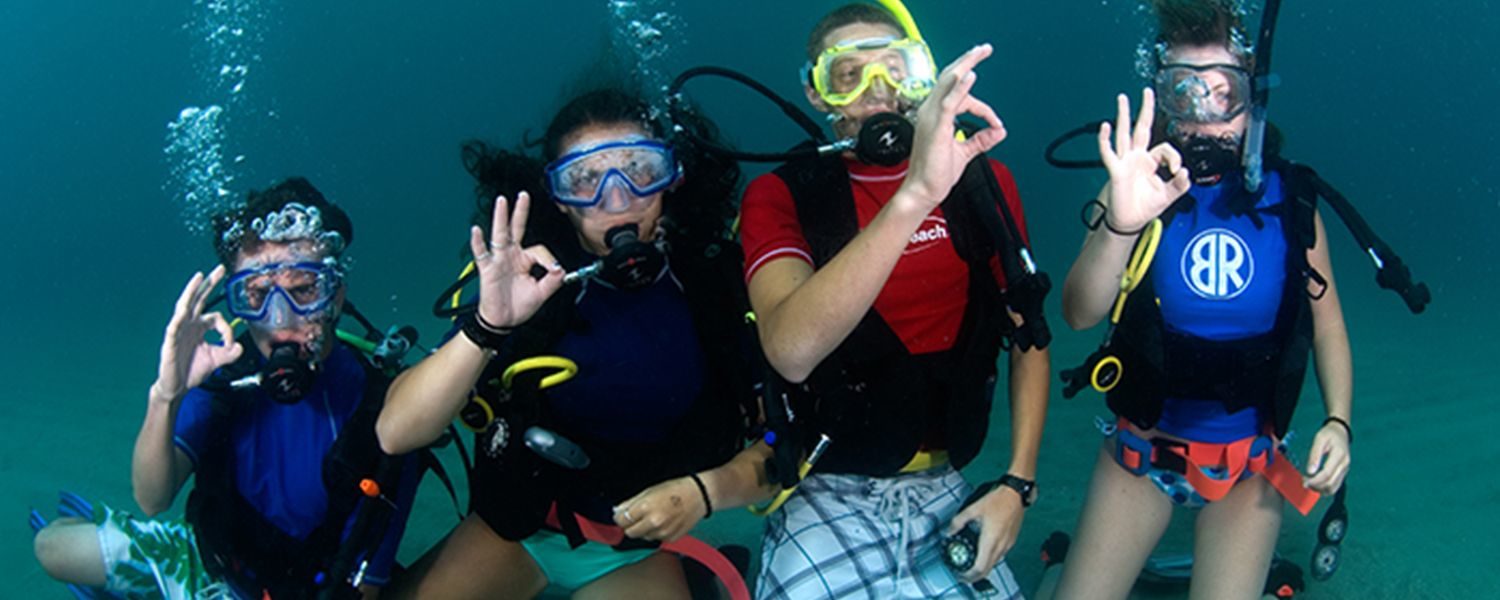
5 tips for being a better teen diver
By: Hannah Tannenbaum, PADI scuba instructor January 24, 2020 High School Adventures, Middle School, Scuba, Marine Biology
At Broadreach, we love to dive. We’ve been working with students for over 26 years, and love seeing a passion ignite when a student takes their first dive. Scuba diving can be challenging at first, so here are a few pointers to help new divers have smooth, successful and fun first dives:
1. Don’t swim with your arms: It’s a completely natural impulse to swim with your arms – after all, that’s how most of us learned to swim. However, our arms are actually very inefficient at moving us underwater compared to our legs, which have the advantage of fins to help us out. Swimming with your arms will make you more tired, may cause you to use your air faster and prevents good buoyancy control. You’re also more likely to hit a nearby reef or fellow diver. Instead of holding your hands together or holding your arms at each elbow while diving, try holding onto part of your buoyancy compensator. As soon as you stop swimming with your arms, your air consumption will improve and you’ll automatically start to slow down as you dive, giving you more control and making for a more enjoyable diving experience.
2. Kick with your whole leg: Swimming with fins takes some getting used to. For many people who aren’t accustomed to using fins, their natural impulse is to kick from the knees. This actually reduces your power and control because you’re only using about two-thirds of the length of your combined legs and fins. Instead, power your kick from the hip and waist area while keeping your knees relaxed and slightly bent in order to slow down your movements and swim with ease and control – this is commonly referred to as “frog-kicking” by divemasters and instructors.
3. Breathe slow, deep and long: Once you get used to swimming using your legs and kicking from your hips, breathing slower, deeper and longer will come naturally because your movements are already more deliberate. Breathing long, slow and deep is a skill that has to be practiced, though! Remember that as you descend, pressure builds and affects the volume of your lungs. If your breath is shallow and rapid at the surface, you won’t be able to maximize your lung capacity at a greater depth. Start thinking about your breath as soon as you put in your regulator to begin your descent.
Practice counting to seven both as you inhale and exhale out of the water, making an entire breath last fourteen seconds. Additionally, you should be sipping the air, not gulping. Remember that if you can inhale and exhale for seven counts outside of the water, you can do it in the water too – it may just take a bit more thought.
4. Make sure you’re properly weighted: Determining your proper weighting is another important skill. Rightly so, most instructors will overweight their students during an open water course in order for them to practice skills at the bottom of the body of water they’re in. However, many people continue to dive with the same amount of weight after their open water course, or use inaccurate matrices to determine weighting based on height and weight. Being over-weighted will put extra strain on your body and make all of your movements more strenuous, causing you to breathe heavier and more rapidly. Having proper weighting will allow you to move easier and slower and exercise more control over your body.
Improve your weighting incrementally – if you deflate your Buoyancy Control Device (BCD) and sink rapidly underwater, it means you are over-weighted. If you are nervous about being under-weighted, ask a divemaster or instructor to bring an extra weight for you just in case. If you are properly weighted, you should have to exhale hard to descend at the start of the dive and ascend at the end using only your breath. Proper weighting is a lifelong process; it’s an aspect of diving that can always be improved and refined, and is also very dependent on where you are diving, the type of exposure suit you’re wearing and the water temperature you’re diving in.
5. Personal awareness: There are so many amazing things to see while scuba diving, from sharks in Fiji to spinner dolphins and batfish in the Red Sea, making it crucial to be conscious of yourself and your body underwater.
Throughout a dive, you should have an understanding of where your body is relative to any reefs and other divers. You should also know your normal rate of air consumption at depths less than 60 feet. This allows you to see your own progress or identify if something is wrong. As you learn to recognize these things, you’ll get better at understanding why they’re happening.
Once you achieve personal awareness, extend that same awareness to your diving buddy. Know where your buddy is throughout the dive, as well as their normal rate of air consumption – this makes you both a better diver and a better buddy. Once these skills become practiced and instinctual, you’ll be able to relax and enjoy diving even more.
